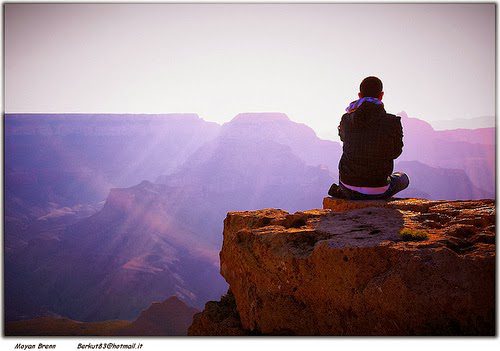Questions and Answers: A Beginners Guide to Meditation
By David
March 6, 2014 • Fact checked by Dumb Little Man

In an extract from her just-published book, Inspiration Meditation, (part of the Go Creative! series) Orna Ross, bestselling novelist and poet and Director of The Alliance of Independent Authors, answers some of the first questions asked by beginners to meditation, allowing you to establish good meditative practice from the start.
When Should I Meditate?
Zen masters recommend that the moment you open your eyes, before the first half-conscious thought has time to form in your mind, you should get out of bed and begin your meditation. Doing it first has many benefits, not least that it sets the tone for your day.
Yogic tradition recommends the times around sunrise and sunset as ideal. This works better in countries close to the equator where sunset and sunrise are relatively uniform. Pick the times that best suit your own schedule.
The effect of meditation is that the connection with creative consciousness experienced on the cushion begins to arise in your everyday life. You can consciously foster this once you’re meditating regularly. You’ll find that gently repeating the word A-l-l in your mind, or giving yourself the instruction to “Enter the space between the words”, will be enough to generate an interlude of peace, joy and creativity for you at any time of day.
How Often Should I Meditate?
Ideally, twice daily. You may need to work up to this.
How Long Should I Meditate For?
Any time spent in silent contemplation is better than none. The ideal amount of time to begin with is twenty minutes, but you may be more comfortable starting with ten, or even five. Aim to build day by day, just as you would build the fitness of any other “muscle”.
Build slowly, no pressure. In these matters, infinite patience delivers instant results.
Most experienced meditators like to do at least 20 minutes. After that, if you wish to increase the amount of time you’re spending in meditation, rather than going beyond 30-40 minutes, it brings more benefit to introduce a second session in the evening.
How Should I Breathe?
Breathe in and out through your nose. As you move into meditation, your breath will naturally slow. Don’t try to make this happen. Just notice it. You will also find the mantra in your mind is likely to synchronize with the breath. Again, don’t work for this. Just enjoy it as it arises.
What Posture Should I Adopt?
In theory, meditation can be done in any position, sitting, standing or lying down. In practice, many people find the metaphysical freedom meditation offers is most easily accessed through a little physical discipline. Your body demonstrates your intention to your mind. The postures and breathing exercises recommended by the ancient sages are those most likely to deliver the mental shift we seek, especially when starting out.
Inspiration Meditation can be done lying flat on your back, as in the yoga pose Shavasana; in a standing pose, like Tadasana; sitting in a chair with the feet flat on the floor, or sitting on the floor in the classic, cross-legged seven-point posture, or the half-lotus or lotus posture.(See postures for Inspiration Meditation here)
Each of these poses encourage alert wakefulness and I use all of them, finding different forms good for different moods. You may want to pick one posture and stick to it. Whichever you choose, in all positions, keep your spine straight and your shoulders, neck and face relaxed; your eyes gently closed; your lips in a half smile; your teeth unclenched; your jaw released; your tongue loose in your mouth; the muscles of your face at ease. Make adjustments with small micro-movements to ensure that you are comfortable.
If sitting, your hands can be cradled, one on top of the other below the navel, elbows held slightly out from your body. If lying, keep your arms by your side in a relaxed position, palms turned upwards.
· If you really need to move while meditating, because of pins and needles, or a cramp, or any other discomfort, that’s fine. Move slowly and quietly, in harmony with the breath, retaining mindfulness.
· A slight anxiety, or an itch, or a wish to move is best observed rather than acted on. It will pass.
· If you find yourself falling asleep during meditation, it means that you are sleep deprived. You will find that regular meditation induces more, or better quality, rest.
· If you need a certain posture, or cushion, or to be with a group in order to meditate well, ensure that you have it. Know yourself. Meet your own needs.
This is an extract from Inspiration Meditation, a “How To Meditate” Guide from novelist, poet and Director of The Alliance of Independent Authors, Orna Ross. Inspiration Meditation is designed to cultivate creativity, ideas and insights. It is not just for writers and artists — though they will find it intensely useful. Inspiration Meditation is for anyone who wants to master the art of conscious creation and apply it to any aspect of life.
| Written on 3/6/2014 by Orna Ross. Orna Ross is an author-publisher. She writes stories, poems and the Go Creative! books and has been named “one of the 100 most influential people in publishing” (The Bookseller), for her work with The Alliance of Independent Authors (ALLi). A long-time teacher of creative and imaginative practice, Orna lives in London and writes, publishes and teaches around the globe. She has a dedicated belief in the power of the published word to transform and liberate. When she's not writing, you'll probably find her reading. |
Photo Credit: Moyan Brenn

